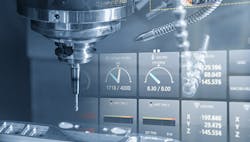CNC builders look to software, machine-health data, customization and modular design
The adoption of on-machine components follows the development of more and more sophisticated hardware and software for better machine-to-machine communication. Increasingly, components are using multiple protocols, facilitating deeper communication for easier access to more in-depth data.
Customers of systems integrators like Methods Machine Tools want solutions for faster and more specific data collection from any protocol, in order to boost production with predictive maintenance insight.
Also read: Automation industry embraces on-machine components
Methods Machine Tools, a machine-tool importer based in Sudbury, Massachusetts, engineers machine tools, automation systems, and provides application and field-service support. Since the company serves manufacturers of every size, shape, and market, some of the most common services for these high-end machines are custom modifications.
“You name it, we have a customer in that industry,” says Guy Parenteau, engineering manager at Methods Machine Tools.
Field service repairs and custom automation cells also represent a large part of the company’s business. In addition to designing and integrating machining processes and systems, Methods has been engineering products, automation, service, spare parts, training and integration since1958.
Machine health data
“The emergence of data as a tool to enable real-time decision making on the shop floor is evolving how companies run and maintain their machines,” Parenteau says. Whereas old alarms signaled the presence of an issue, detailed diagnostics can instead tell operators precisely what the issue is.
For example, rather than just letting an operator know how much cutting fluid is in the coolant tank of a CNC machine, more advanced on-machine components could tell someone the viscosity and temperature of the fluid. That information can be used to improve machining processes and resolve minor issues before they become costly problems. Coolant flow is another variable that is closely monitored in CNC machine tools, as it can have a direct impact on shop productivity or part quality, he says.
“One of the biggest trends is monitoring the health of your machine, which enables you to maximize its output and monitor profitability,” says Connor Brown, controls engineer at Methods.
Coolant levels and usage are two areas that deserve close scrutiny, as they can affect the condition of a workpiece or throughput. “If you can determine your coolant is affecting your surface finish, for example, next, you could invest in a better cleaning or filtering solution,” Brown says. Not only would this extend the life of the machine tool, but it would also help establish a more consistent manufacturing process and more customer-ready parts.
Methods likes to use a Keyence clamp-on flow meter for some applications, so users can monitor the coolant flow going to the machine. “Customers like it because it has a great big visual, and you can read it from a good distance away,” Parenteau says.
To access more real-time data on the coolant systems, Methods has upgraded some machines by changing coolant switches from discrete to analog. “We used some analog float switches from ifm Effector to give us real-time data of the coolant level, not just high-low, but an actual value throughout the height of it,” he says.
That is done by switching from a simple ball-float switch to something like a radio probe, Brown says. “We can monitor the height of all our tanks and calculate how much coolant we have in the tank.”
The data revolution, while boosting the industry’s ability to proactively detect and resolve machining issues, can be overwhelming for some machine shops, Parenteau says. “There’s so much data that you could collect, demonstrate and visualize,” Parenteau says. “The challenge is knowing where to begin.”
One good place to start, Brown said, is production dashboards. “You can put a smart light on your system and just with basic information like a machine alarm, machine cycle or machine idle, you can produce a dashboard and get metrics throughout the day on how the production shop is functioning,” Brown says. This can help identify shifts or specific times of day that encounter problems or pinpoint the cause of unknown issues.
Networking standards like IO-Link, which communicates information between different sensors and actuators, allow systems to gather more concentrated data. “An integrator could, for example, use IO-Link to get a more specific error message and diagnostic data, then program the machine tool to give the operator a more robust, clear error message,” Brown says.
For example, Parenteau said, a less-sophisticated system using a single discrete input ball float switch might just display “coolant alarm” when triggered. If the shop wanted a more detailed alarm – telling someone whether the coolant level is too low or high – an integrator would need to add additional floats for each separate alarm condition. When physical space is a problem, it might be too cumbersome to add multiple float switches.
“Using a single IO-Link enabled level sensor gives you the ability to read the entire travel of the sensor at any point,” Parenteau says. “Consolidating the space needed while also giving you a huge number of possible measuring points.” This would give the shop the ability to create and combine any number of display messages and conditions.
With modern protocols and networking setups that require less hardware and improve ease of use, users don’t need an individual sensor for every possible iteration of an error. This would require more holes and wires, instead, one sensor can collect and communicate more focused data.
Custom and modular
As real-time analytics become more commonplace and communication networking continues to evolve, operators benefit from the ability to monitor machine performance metrics at the component level. This type of detailed analysis requires individualized systems to focus on the needed data for a specific application, just as each machine will match the customized application and customer.
“It’s becoming more common for machine-tool builders to overlay their own interfaces to existing controls,” Parenteau says. “It’s common for builders to take the Fanuc control and add their own screens on top of that, customizing the control to the machine.”
Other builders add their own software to Fanuc controls so operators can monitor tool-length compensation and tool management. “Traditionally, you’d have to use a tool presetter to be able to determine tool lengths and tool offsets. You can still perform that function, but some builders provide their own software that lets you automatically mount the tool to the spindle and bring it to a designated position and guide you through the same process at the machine control,” Brown says.
Most builders implement similar functionality, Parenteau adds. “They’ve started to take the good things about the preexisting setup and fine tune to what’s better and easier to navigate,” Parenteau says. “The big drive that we’re doing is based on user experience and user satisfaction, so whatever you can do to make it an easier learning curve for the customer.”
Methods products of CNC machines use a Fanuc control, and each builder can choose among the many control options from Fanuc. They might add a specific probe or a customized tool changer. “It’s advantageous for them to create their own screens to allow more seamless interface for the operator or end user. It makes it more intuitive and streamlined for walking through a process on the control,” Brown says. Instead of paging through a thick manual, the software can provide users with step-by-step instructions with status LEDs that indicate once something is complete.
“Fanuc has supplied the ability for an integrator like us to create custom screens for some applications for a customer,” Brown says. For an aerospace customer, Methods’ engineers added a tool-oscillation module to the machine. “Operators had to adjust the power level of the module to change the frequency and oscillation. Methods’ engineering team created software to adjust the power level from a familiar Fanuc control,” Brown says. Without that software, he says, the operator would have to go into the cutting program and make changes manually, introducing an opportunity for error.
“By utilizing the control software and tutorials we created, they’re able to get a couple runs out of the same tool without making many changes,” Brown says. “You’re minimizing the amount of time at the control, you’re doing the setup once for the life of the tool, and then you can run autonomously until you change that tool out.”
Remote access capability
The pandemic has only increased the need for remote and mobile access to machine systems. More and more data and production dashboards are available remotely with access via a smartphone. More devices are also implementing Bluetooth and near-field communication (NFC) connectivity, allowing operators and machinists to view settings and data from a device. “You’re not chained to using a computer and software away from the shop floor,” Brown says. “Most people have a phone in their pocket, and next-generation devices are coming out with new ways to connect to a device, making it easier to setup your system or change a configuration.” Bluetooth capabilities are making it easier for integrators to get systems up and running. “It’s streamlining the way that we set up systems on the floor,” Brown says.
About the Author
Anna Townshend
Managing Editor
Anna Townshend has been a writer and journalist for 20 years. Previously, she was the editor of Marina Dock Age and International Dredging Review, until she joined Endeavor Business Media in June 2020. She is the managing editor of Control Design and Plant Services.

Leaders relevant to this article:


